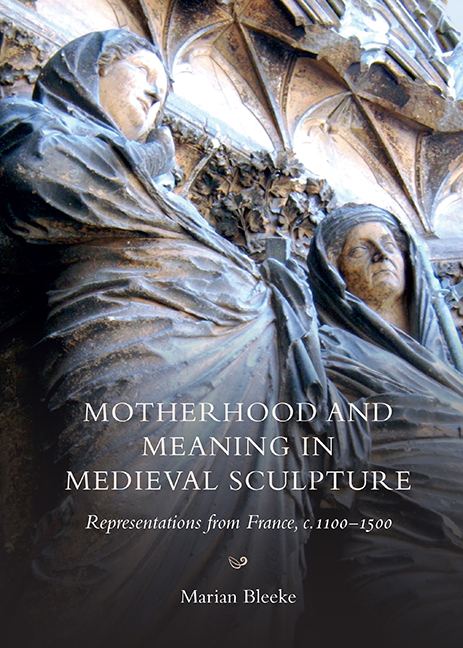Book contents
- Frontmatter
- Contents
- List of Illustrations
- Acknowledgments
- Introduction: Motherhood and Meaning in Medieval Sculpture
- 1 Motherhood as Transformation: From Annunciation to Visitation at Reims
- 2 Motherhood as Monstrosity: The Moissac Femme-aux-serpents and the Transi of Jeanne de Bourbon-Vendôme
- 3 Resurrecting Lazarus: The Eve from Saint-Lazare at Autun
- 4 Visualizing Parturition: Devotional Sculptures of the Virgin and Child
- Afterword: Motherhood and Meaning: Medieval Sculpture and Contemporary Art
- Bibliography
- Index
- Already Published
Afterword: Motherhood and Meaning: Medieval Sculpture and Contemporary Art
Published online by Cambridge University Press: 29 May 2021
- Frontmatter
- Contents
- List of Illustrations
- Acknowledgments
- Introduction: Motherhood and Meaning in Medieval Sculpture
- 1 Motherhood as Transformation: From Annunciation to Visitation at Reims
- 2 Motherhood as Monstrosity: The Moissac Femme-aux-serpents and the Transi of Jeanne de Bourbon-Vendôme
- 3 Resurrecting Lazarus: The Eve from Saint-Lazare at Autun
- 4 Visualizing Parturition: Devotional Sculptures of the Virgin and Child
- Afterword: Motherhood and Meaning: Medieval Sculpture and Contemporary Art
- Bibliography
- Index
- Already Published
Summary
Death, doubt, empowerment, grief, hope, intimacy, joy, life, loss, pain, presence, release, salvation, separation, subordination, suffering, validation: together these terms summarize the complexity of motherhood as an experience for medieval women as it has been reconstructed in this book through work with selected medieval sculptures. This complexity, expressed most clearly in the contradictions contained in certain pairs of these terms (empowerment/subordination, death/life, grief/joy, intimacy/ separation, and so on), may have marked the experiences of individual women, over one or more pregnancies, and would have marked the cumulative experiences of women as a group.
A young woman in Reims in the late thirteenth or early fourteenth century, who worked in the market in front of the cathedral, might have encountered its Annunciation and Visitation sculptures during her first pregnancy and used them to think about the ongoing changes in her body and the upcoming change in her identity once she became a mother (Figs. 2–3). A few months later, she might have looked back at the Visitation sculptures and recognized in their elaborate forms the celebration of her new motherhood during her Churching: then, looking across the space of the portal, she might have seen in the Presentation sculptures her husband's assertion of his power within their marriage during the post-Churching feast (Figs. 5 and 7). Over the years, through repeated pregnancies, the Annunciation, Visitation, and Presentation sculptures may have come to represent for her the highs and lows of marriage and motherhood. Years later, as a widow, perhaps now running her husband's stall in the market, she might have recognized in Elizabeth's rich visual form and mature face her own newly independent status. Another young woman who had decided to become a beguine, and who came to the cathedral for Candlemas, might have recognized in the Annunciation, Visitation, and Presentation sculptures instead her developing sense of an interior encounter with the divine. Or perhaps the first woman decided to become a beguine as a widow and now saw in these sculptures both a continuity from her earlier life as a wife and mother, in thinking of the divine presence within her as like that of a child, and a difference, in her transformed relationship to male, now clerical, authority.
- Type
- Chapter
- Information
- Motherhood and Meaning in Medieval SculptureRepresentations from France, c.1100-1500, pp. 159 - 174Publisher: Boydell & BrewerPrint publication year: 2017

